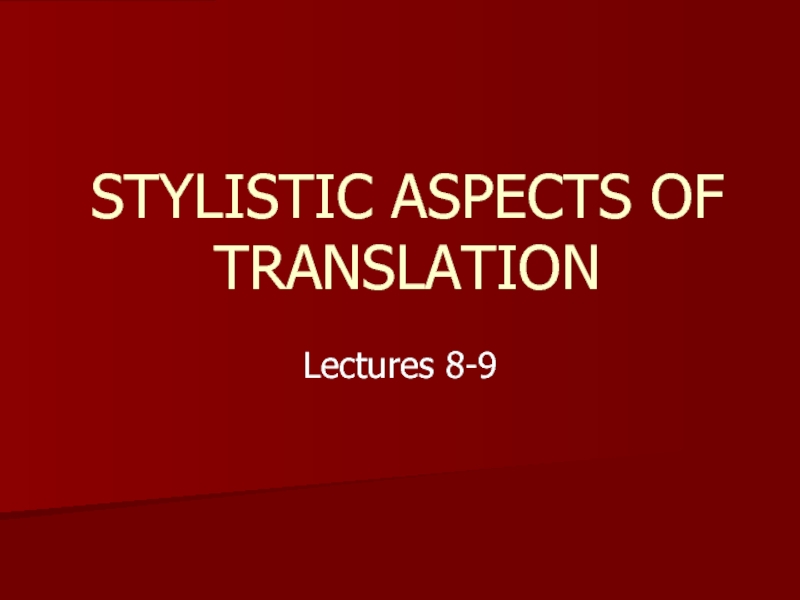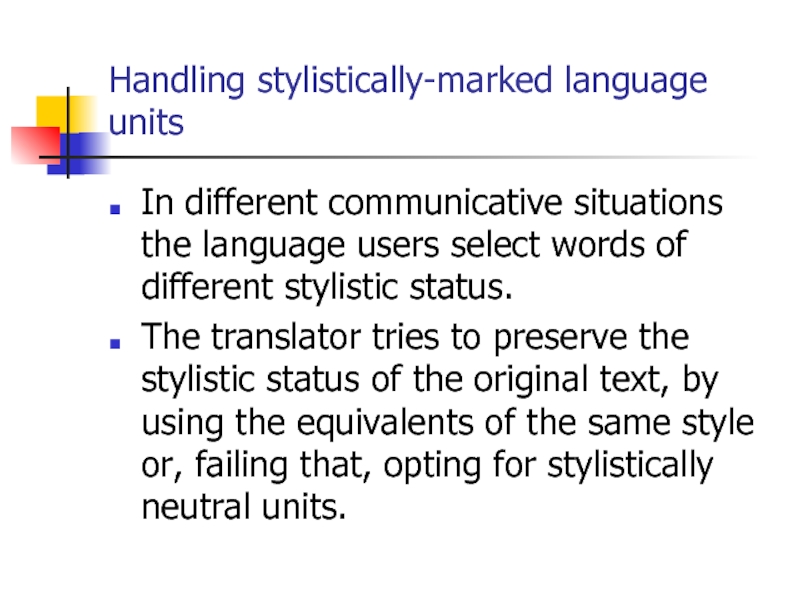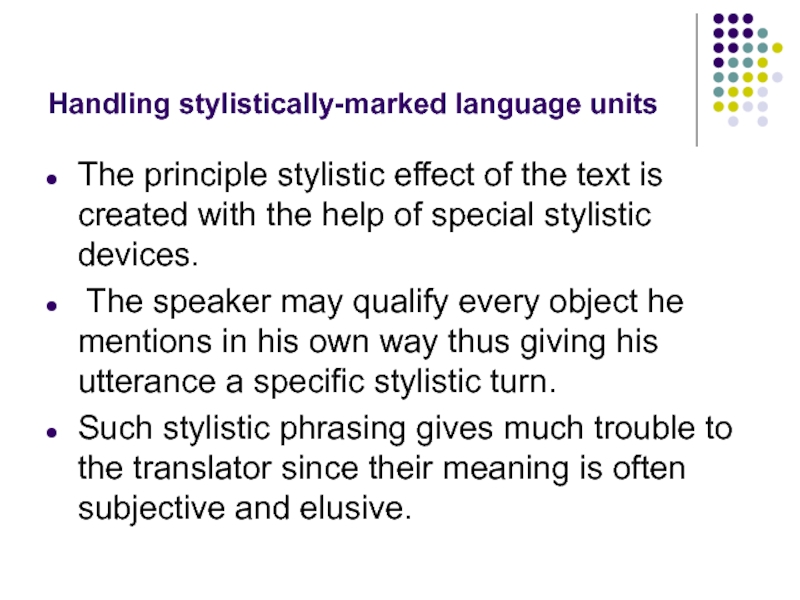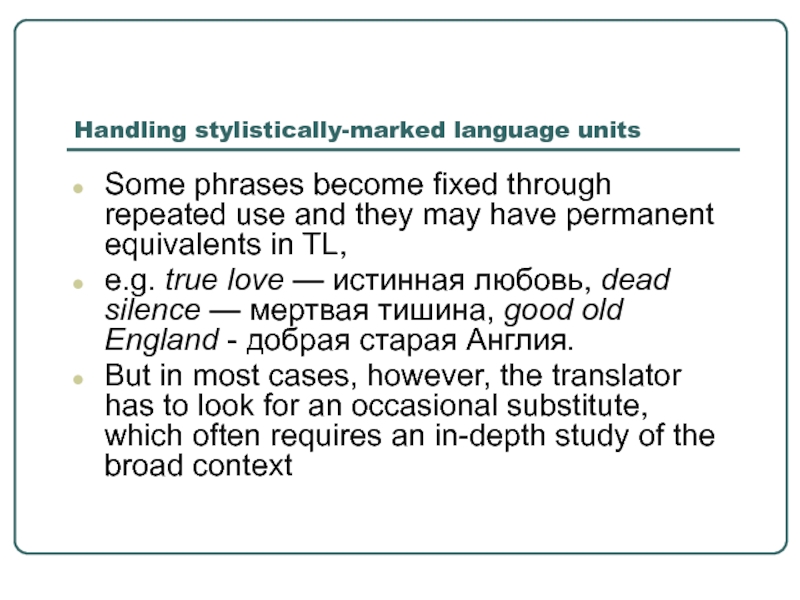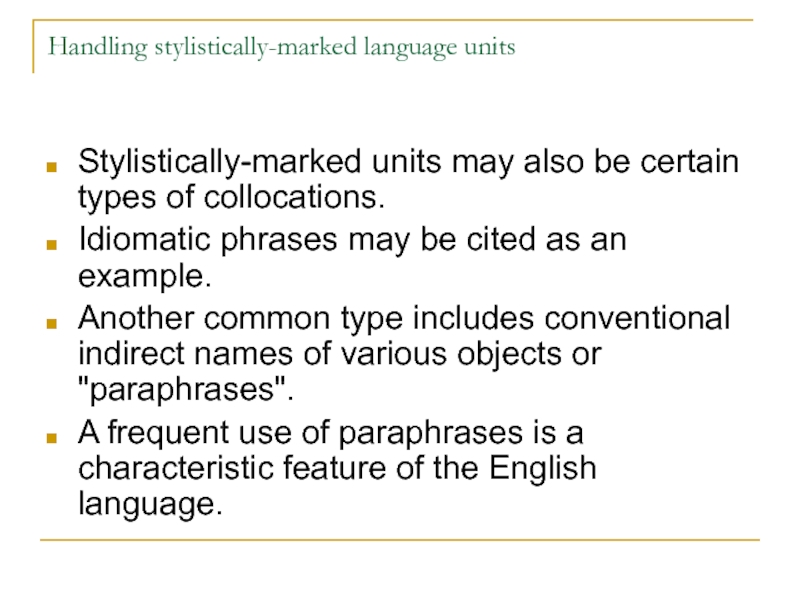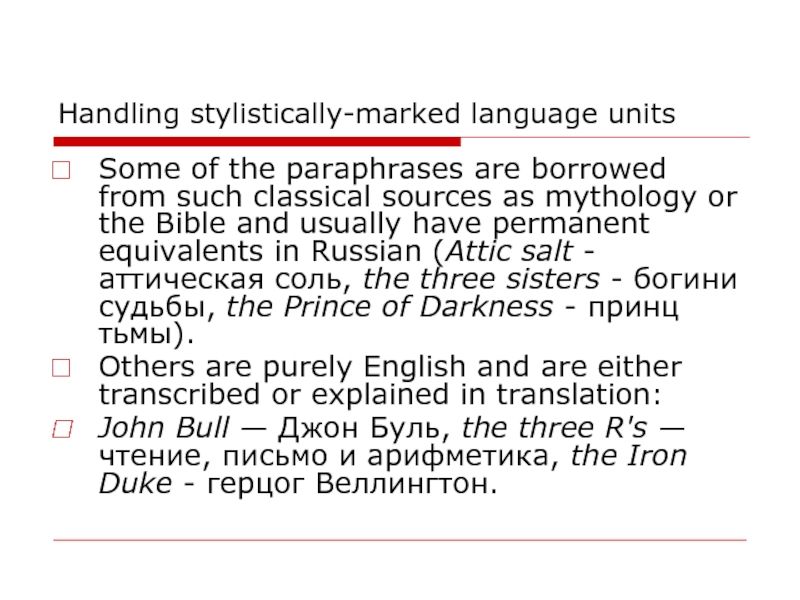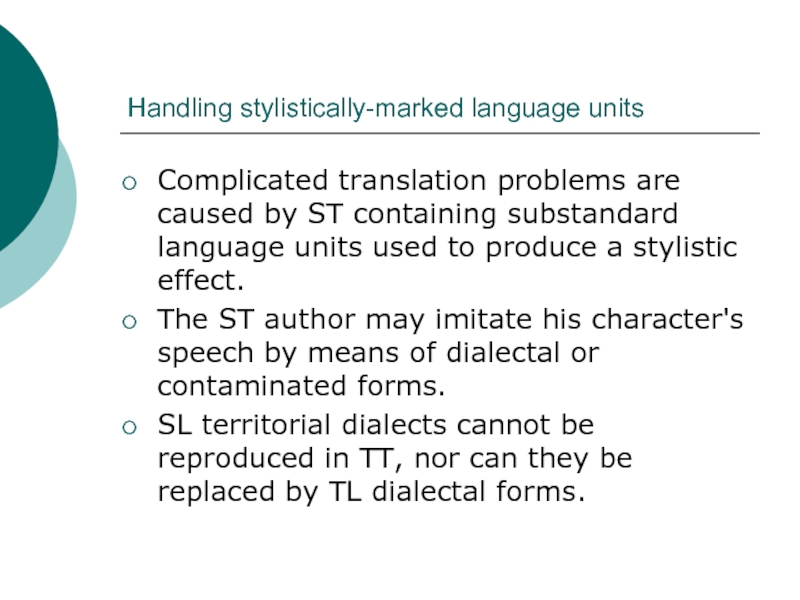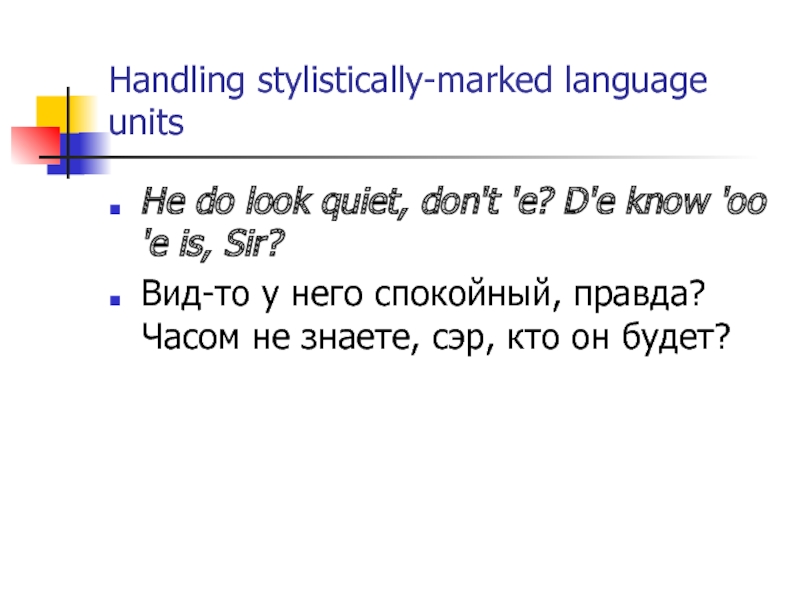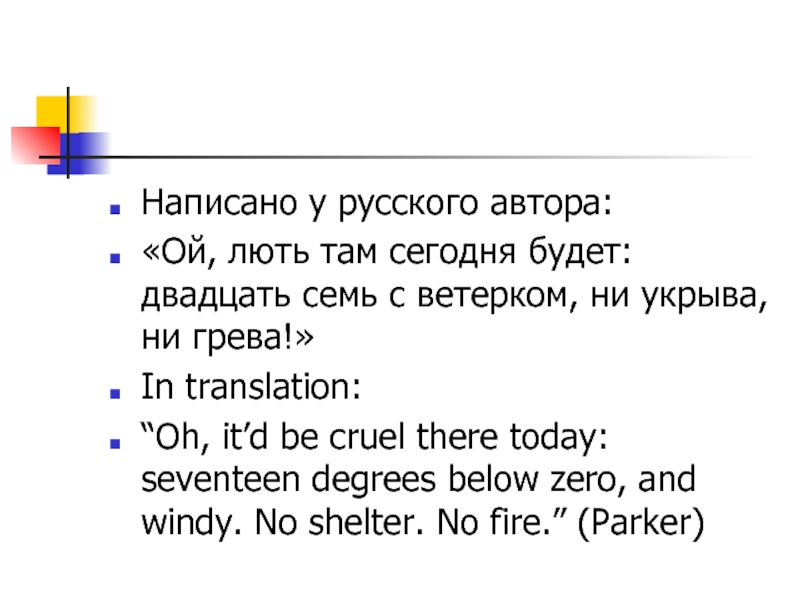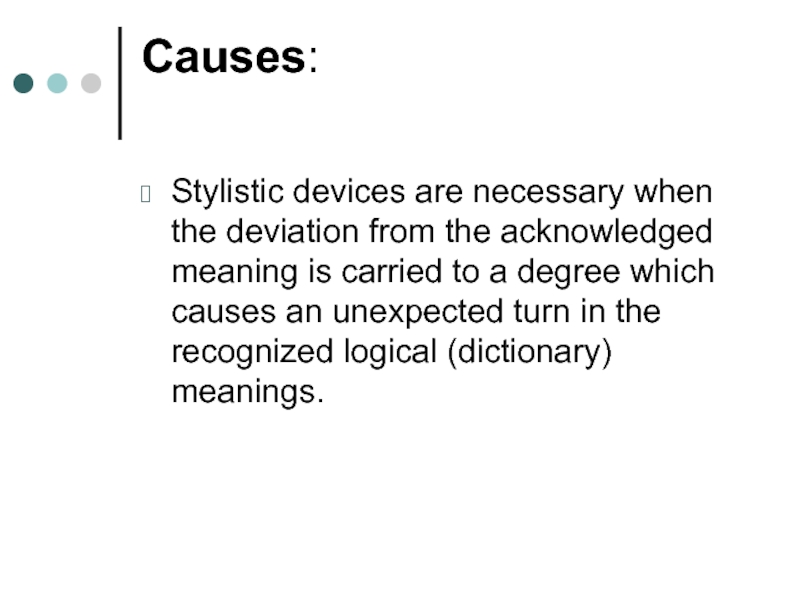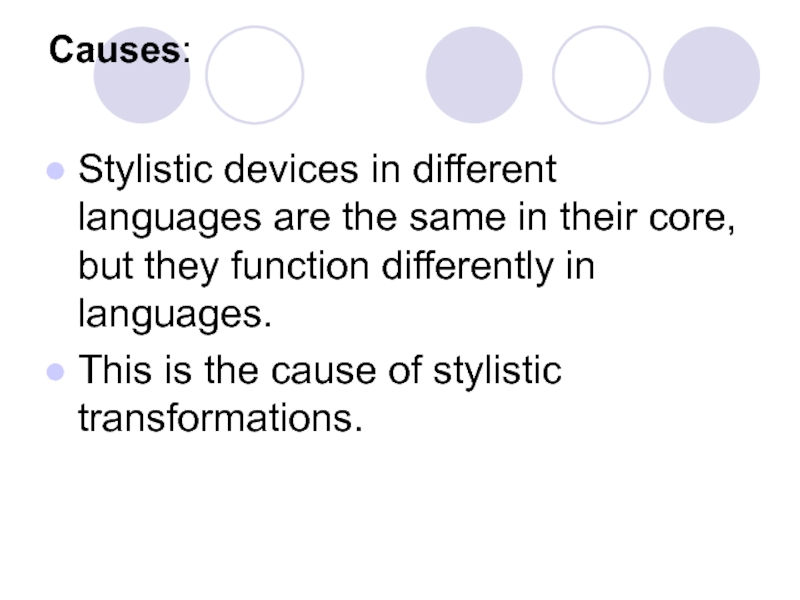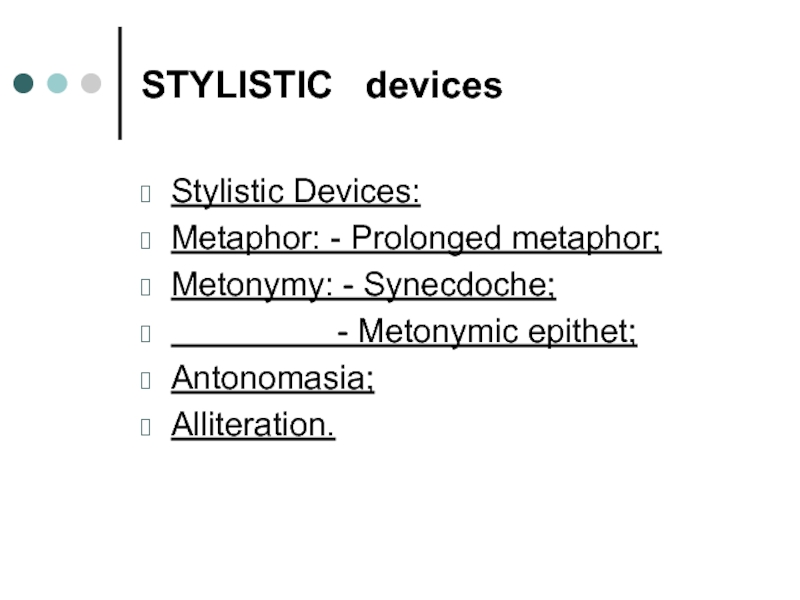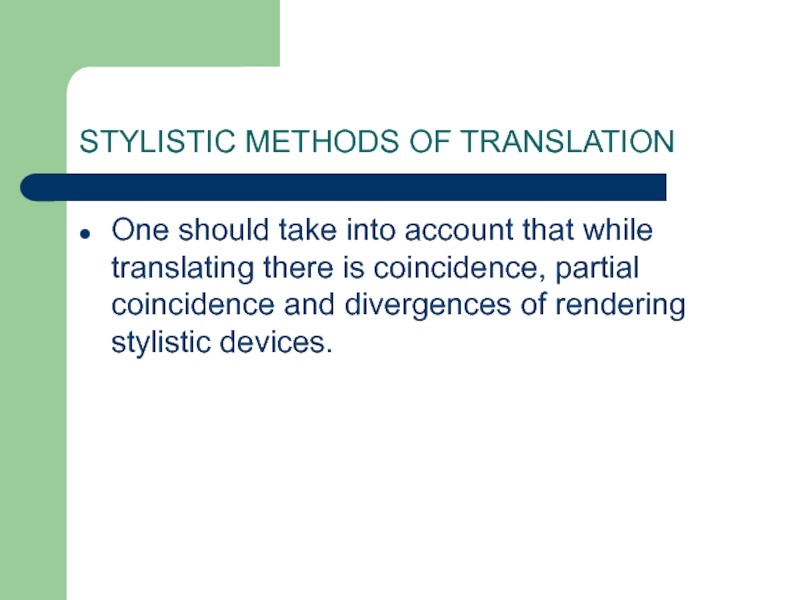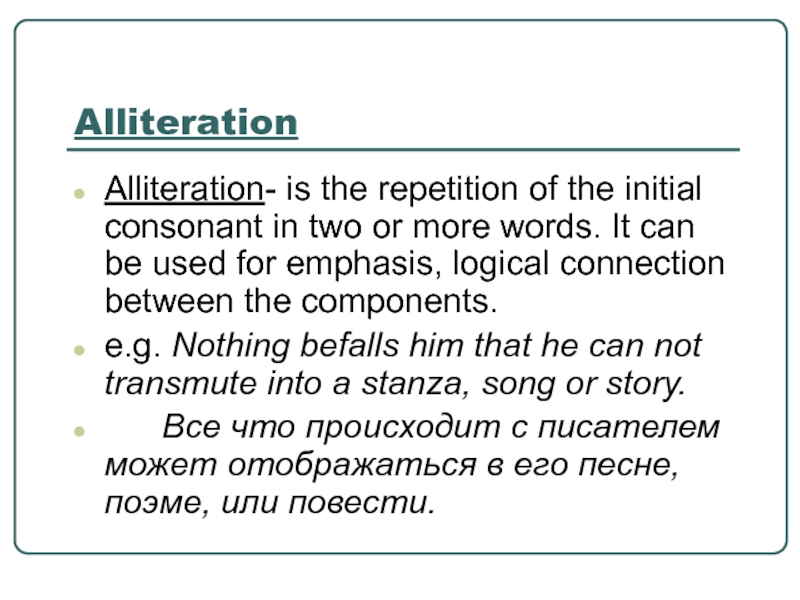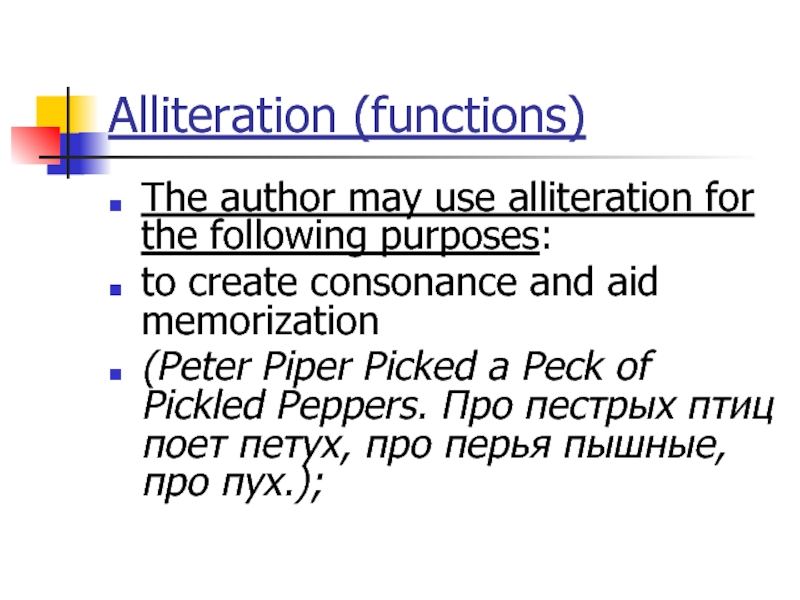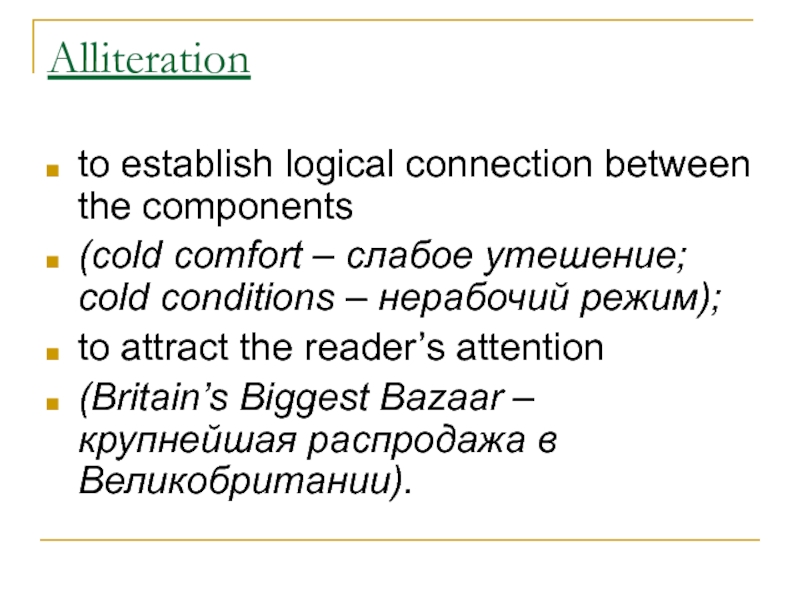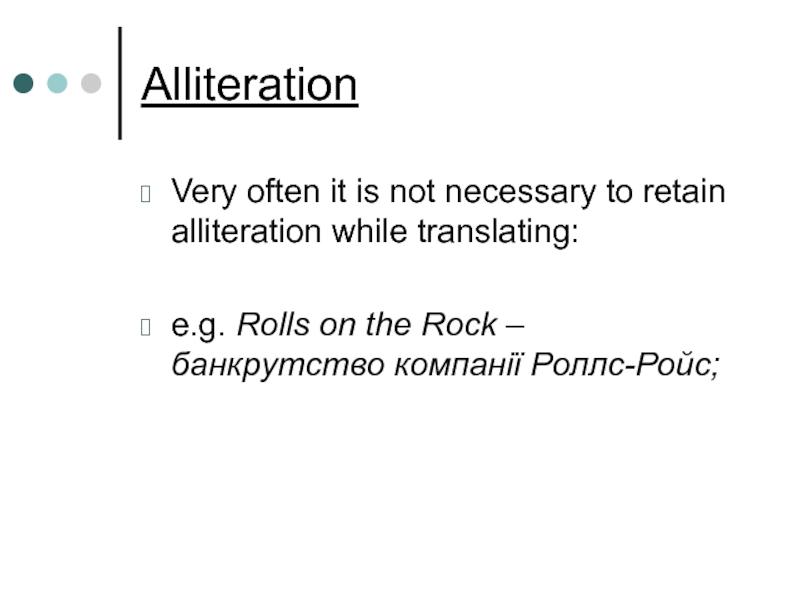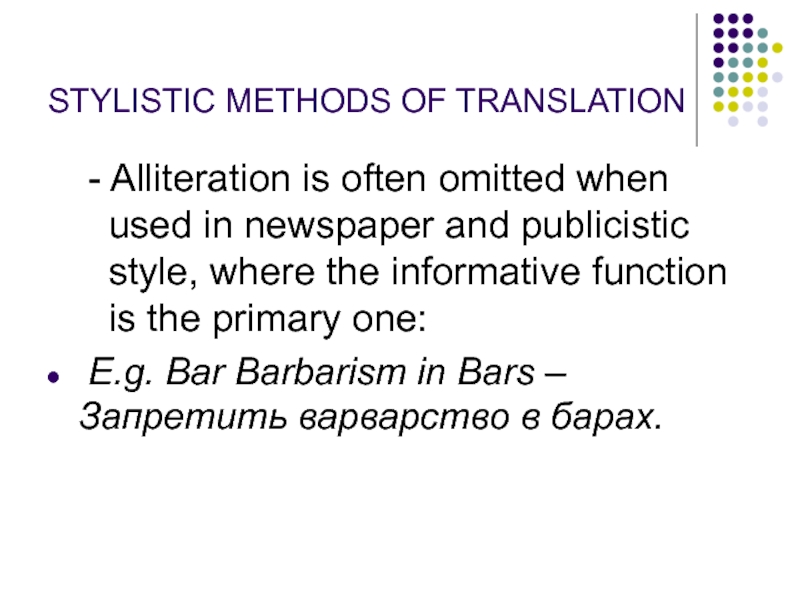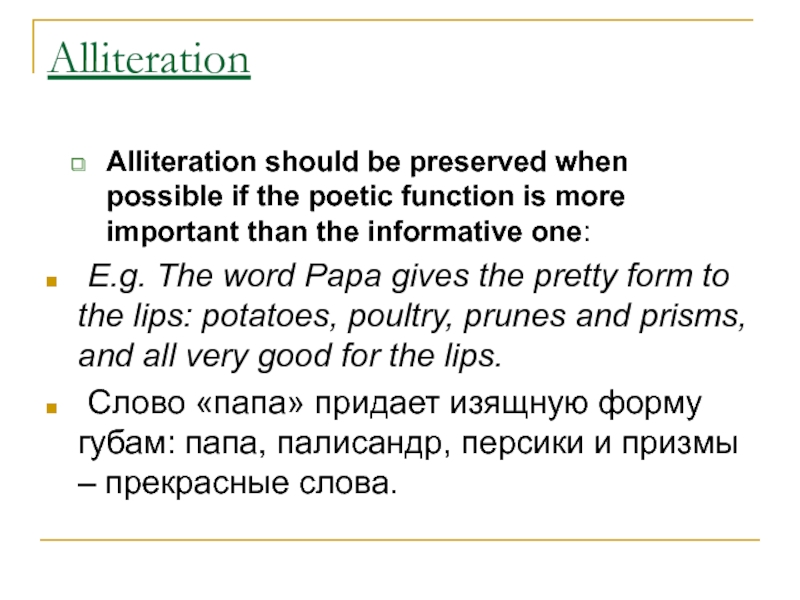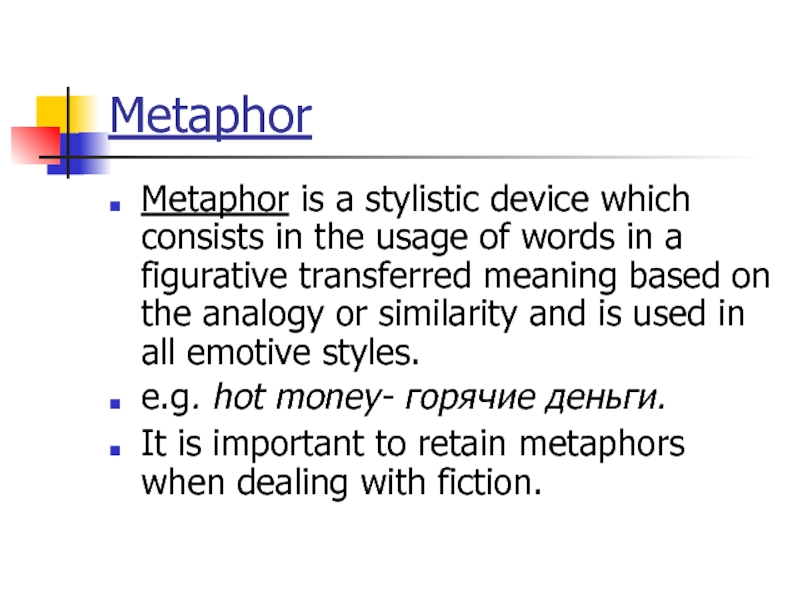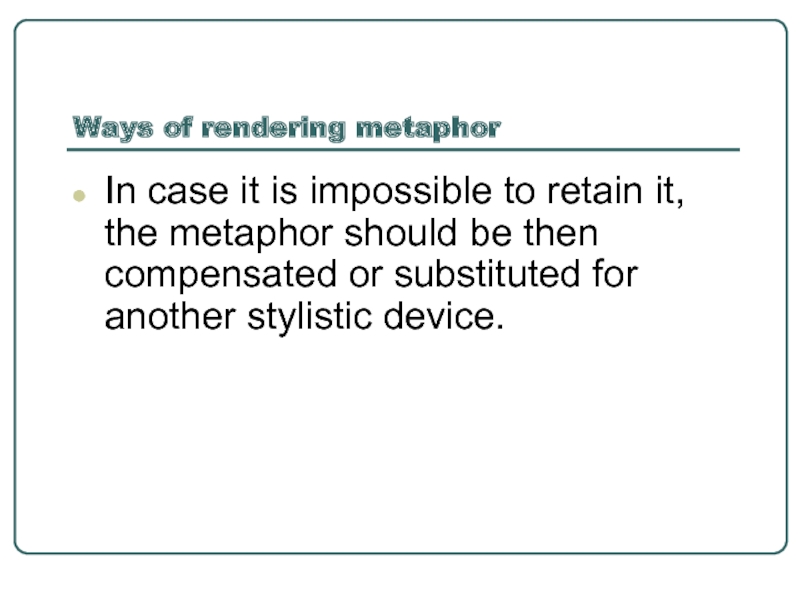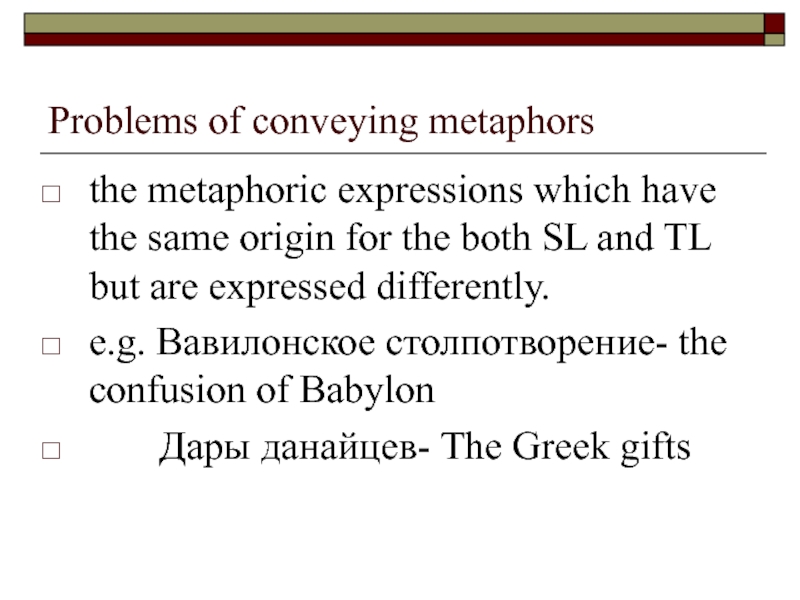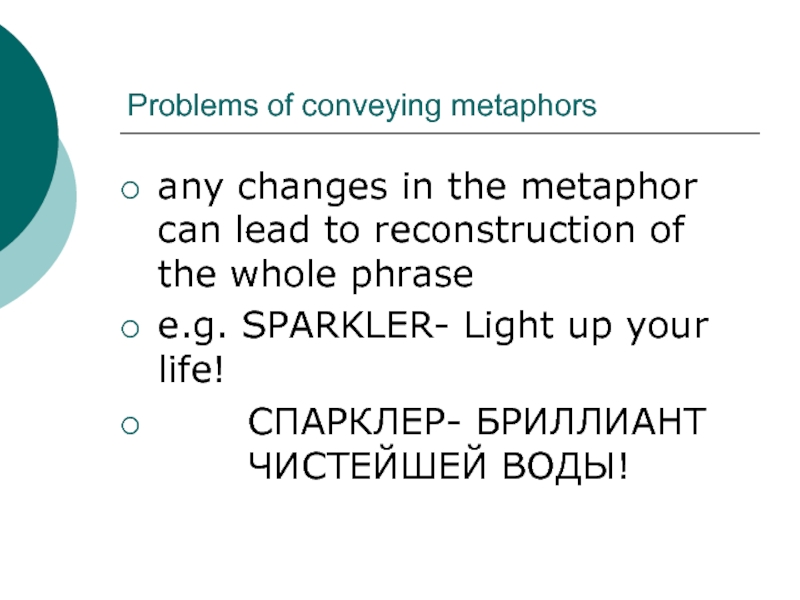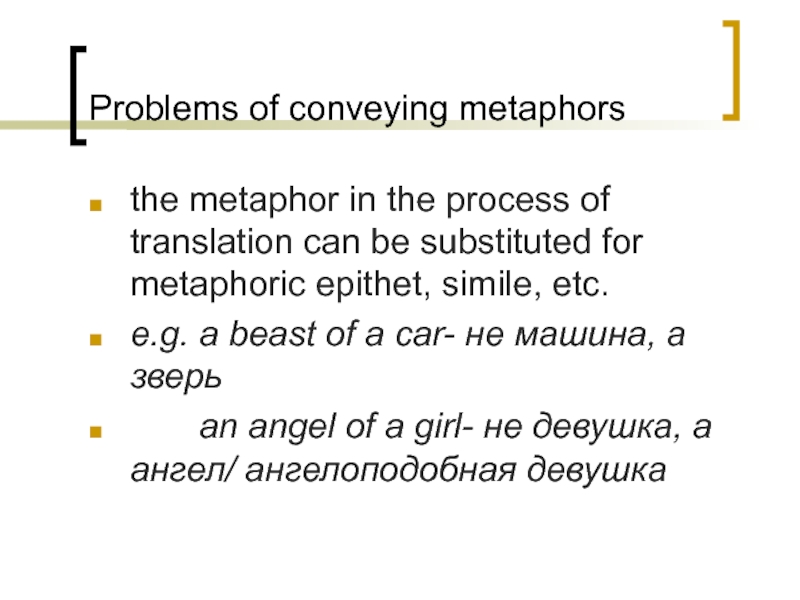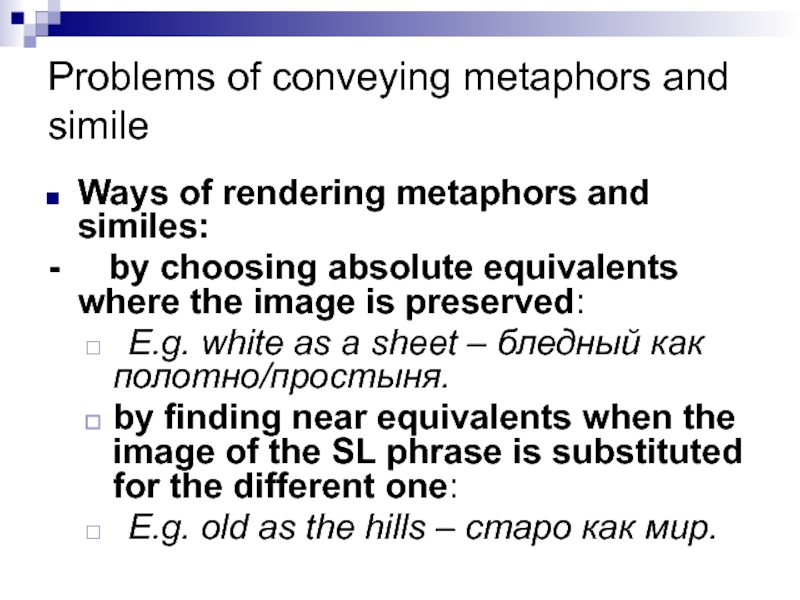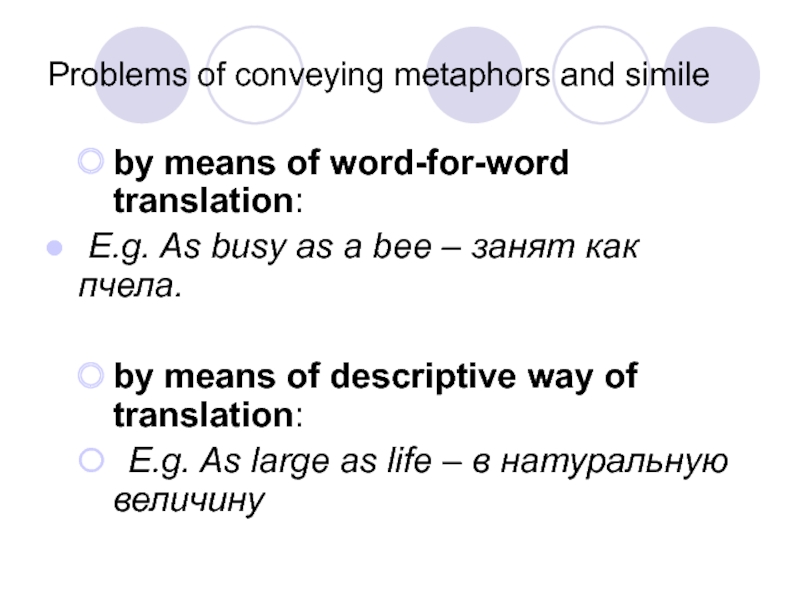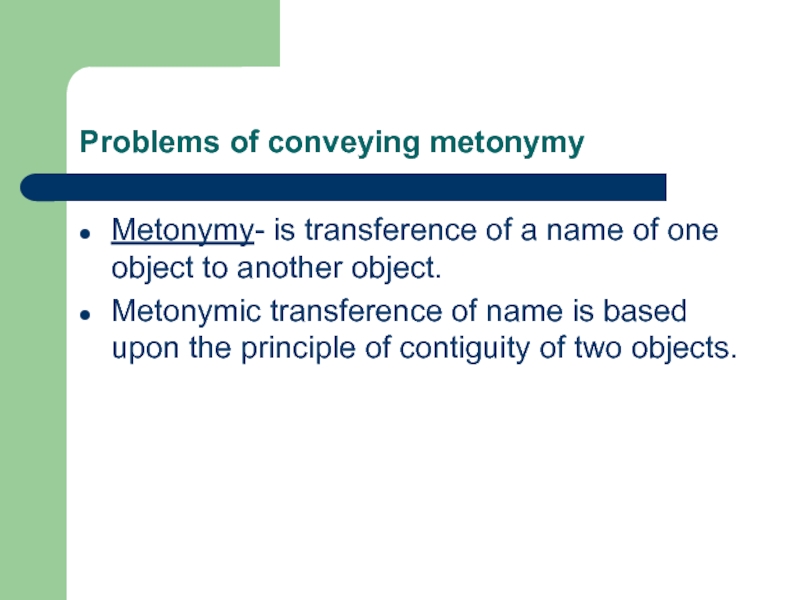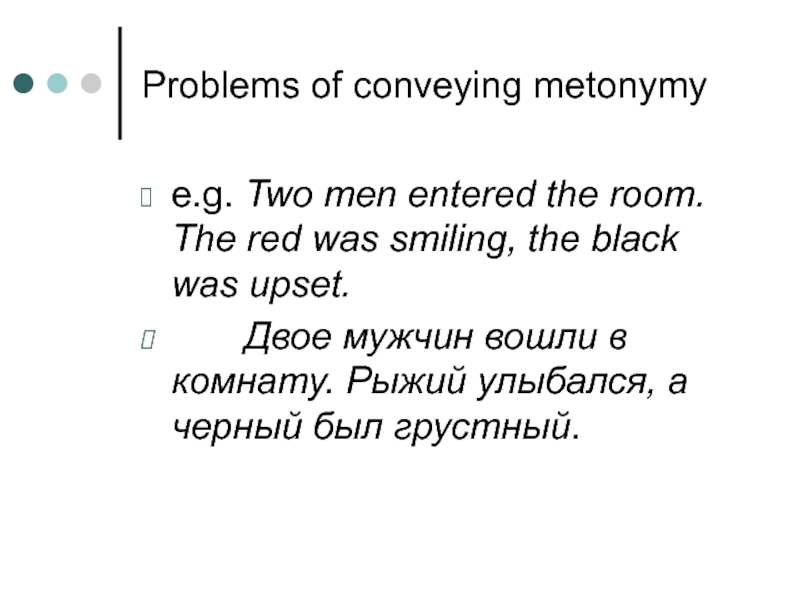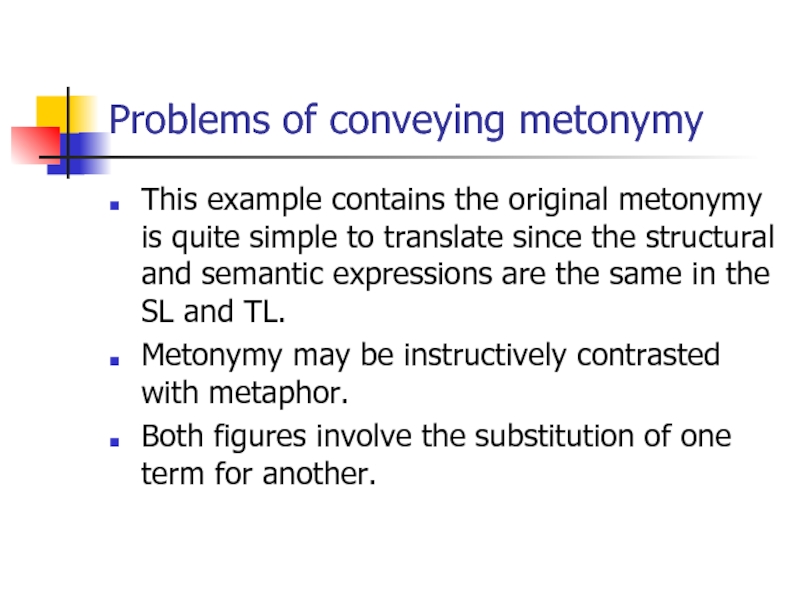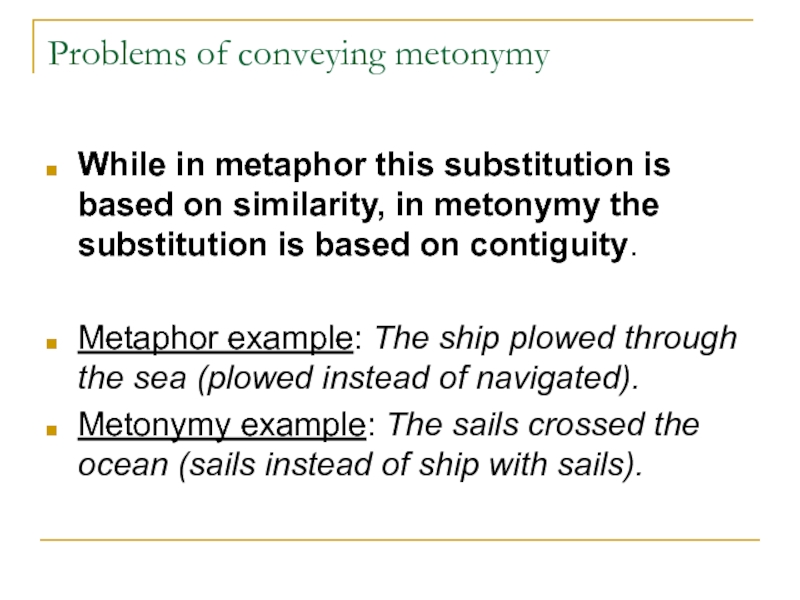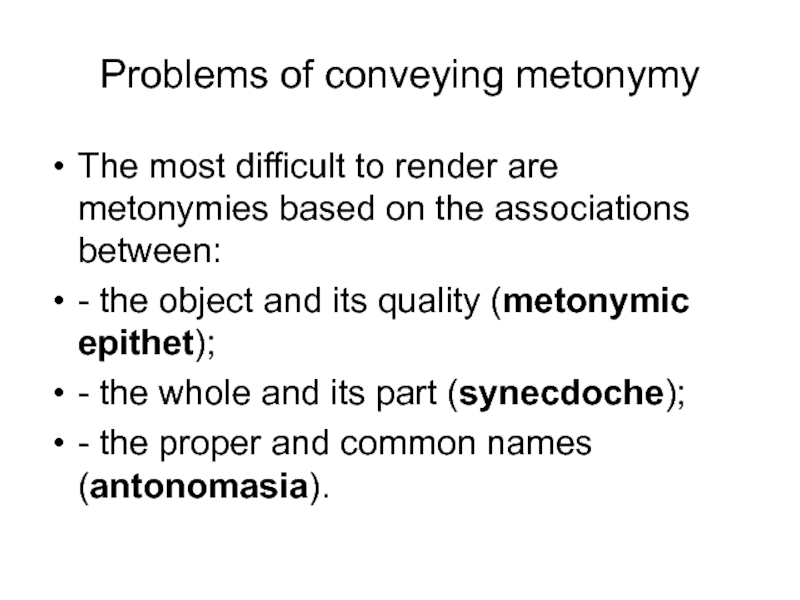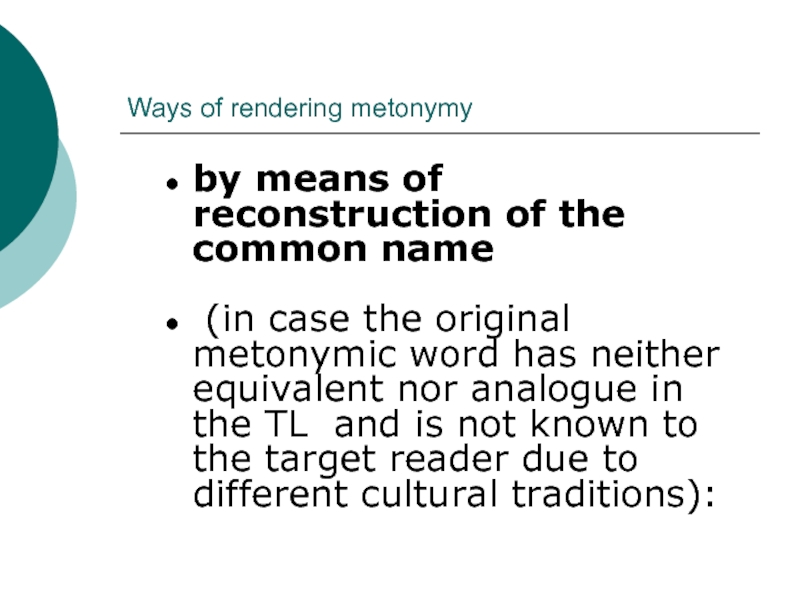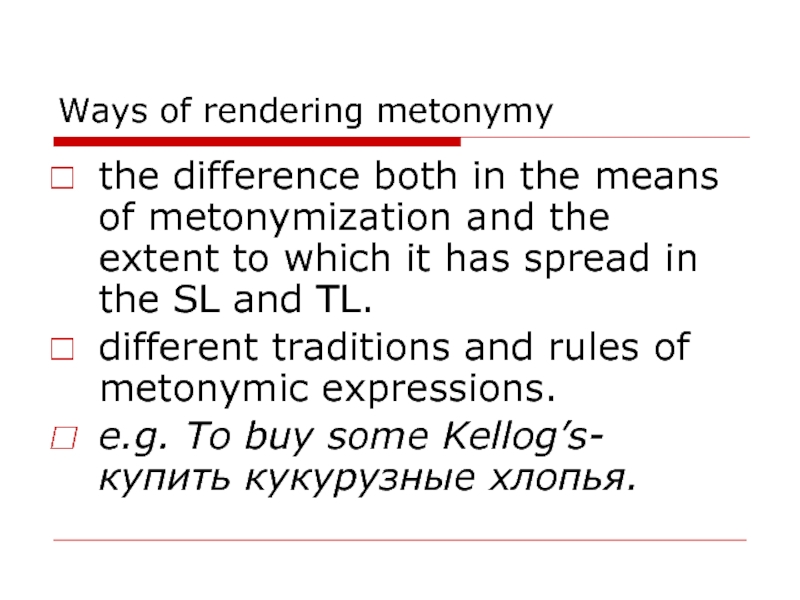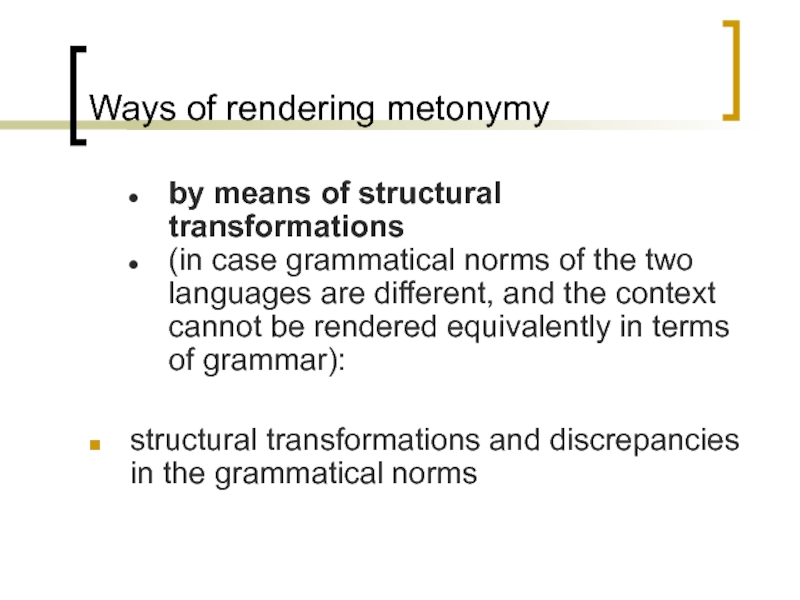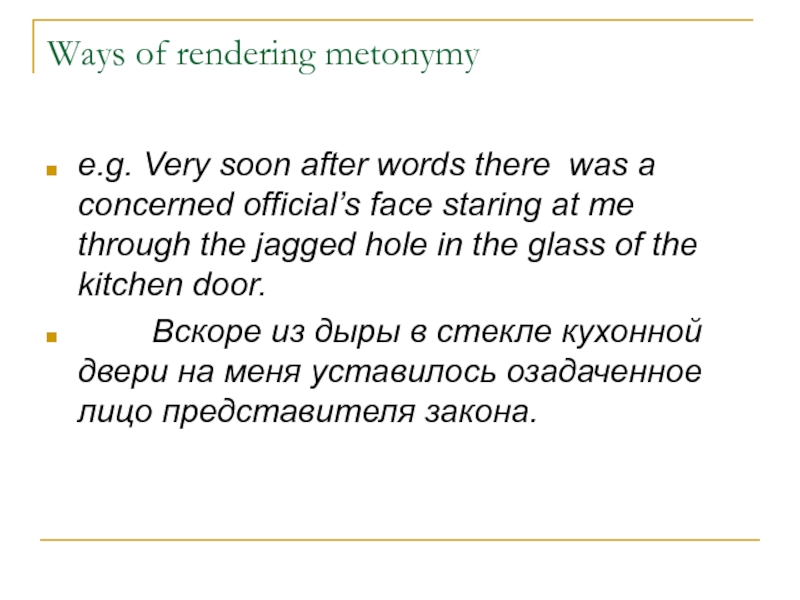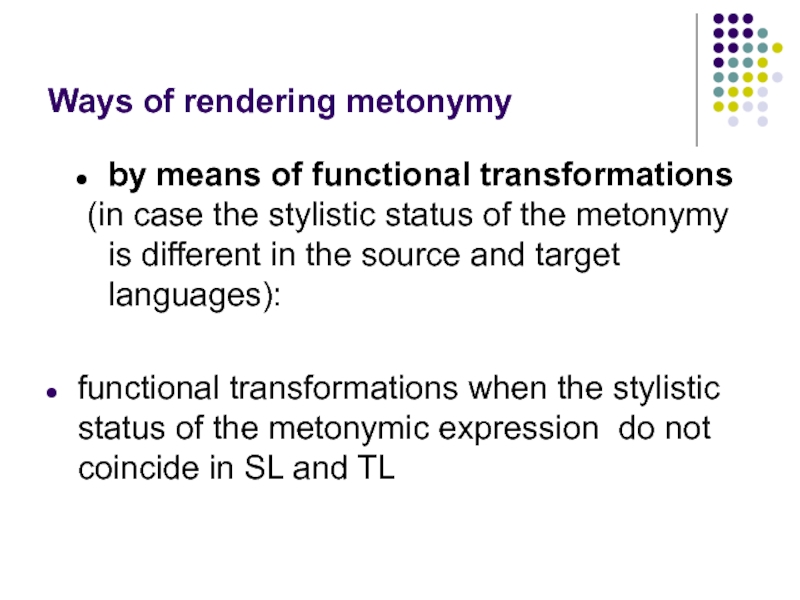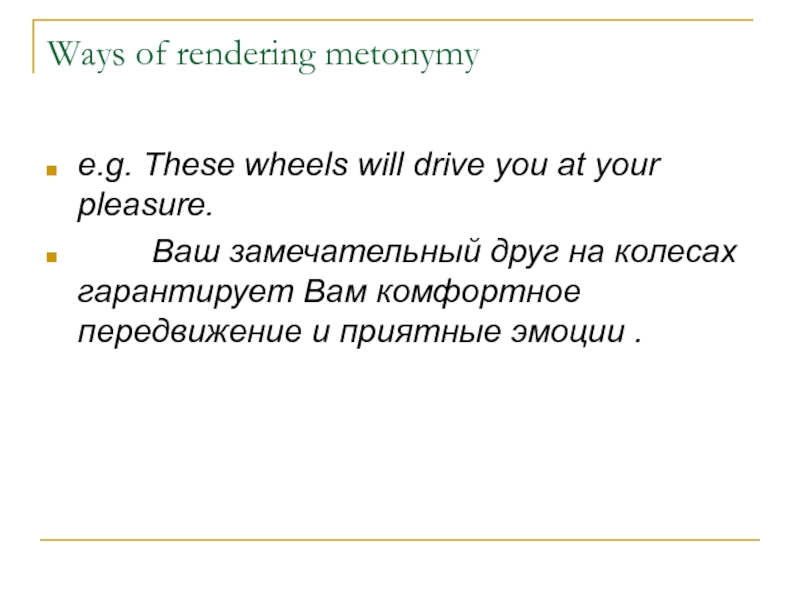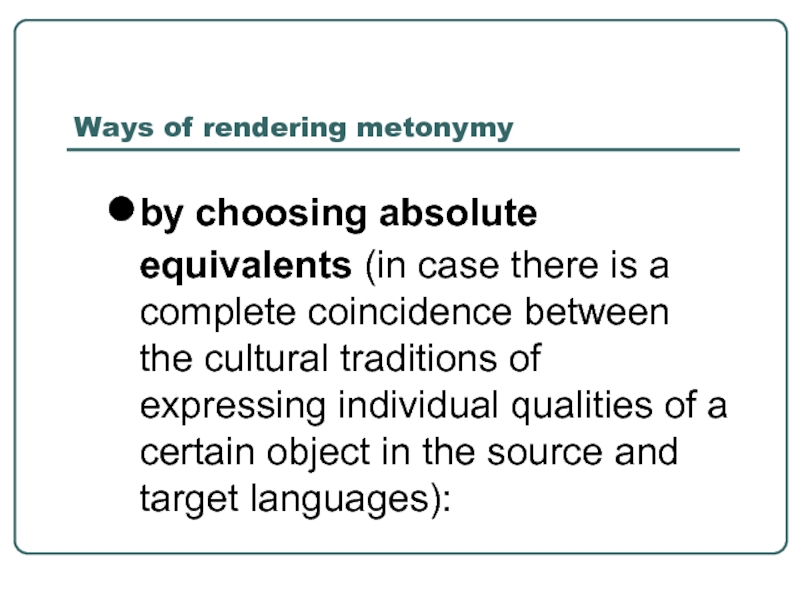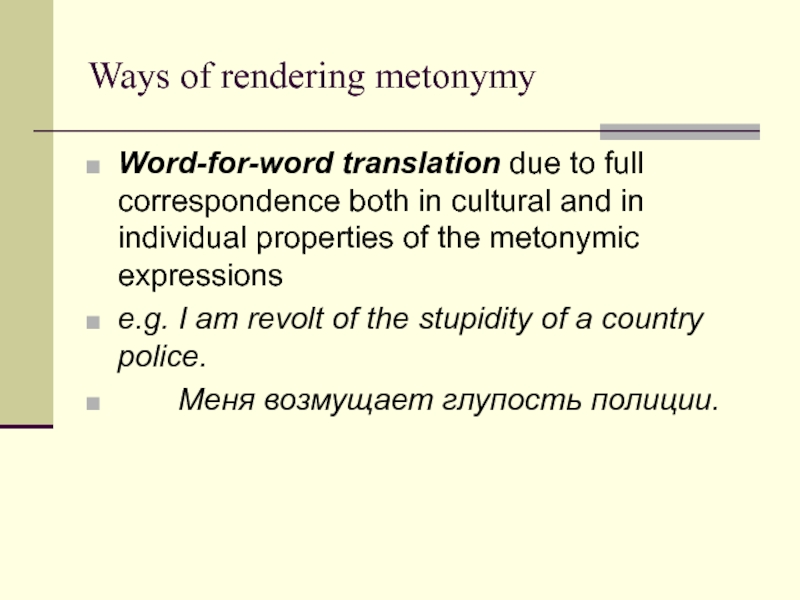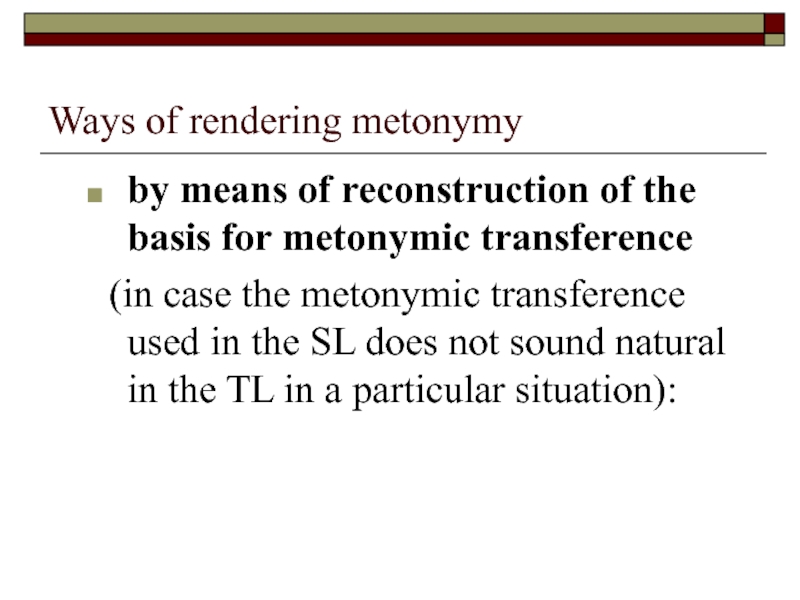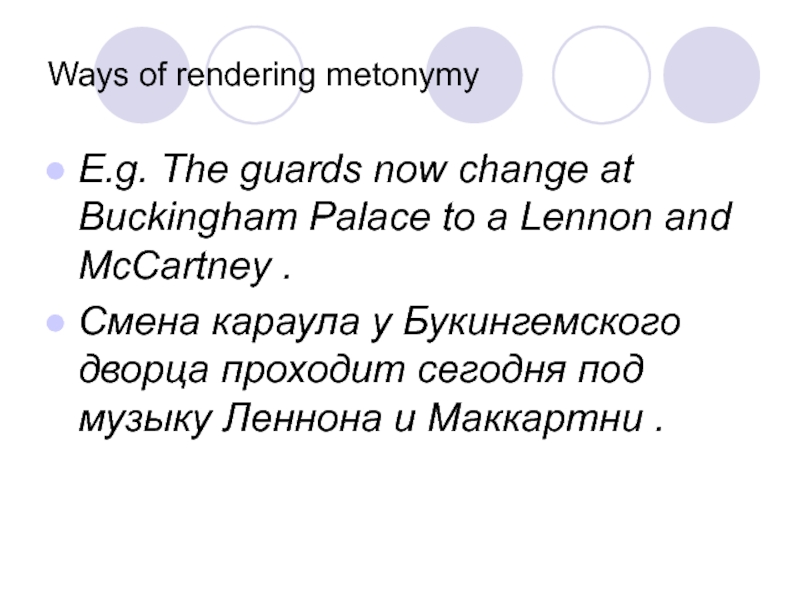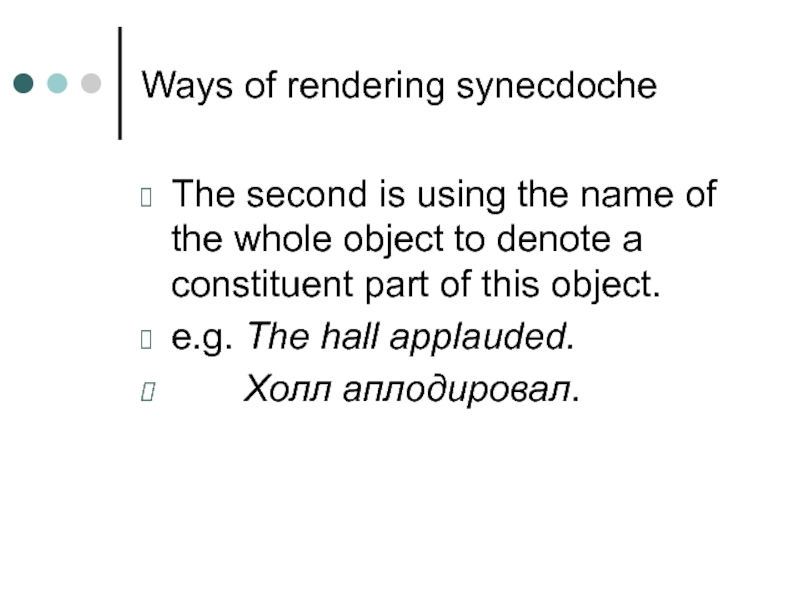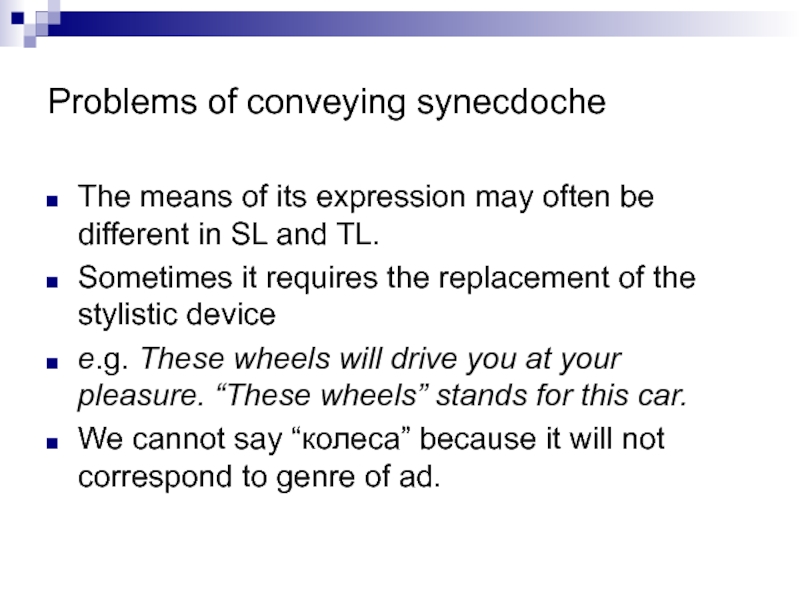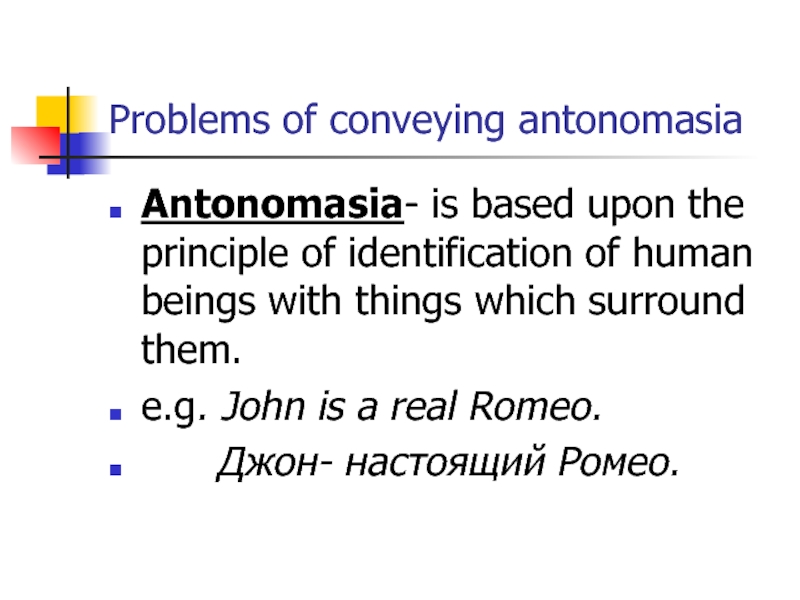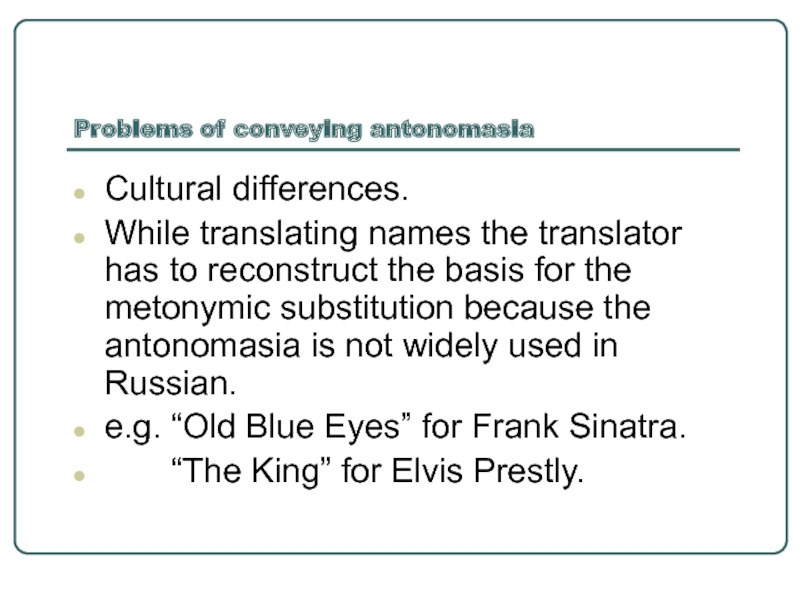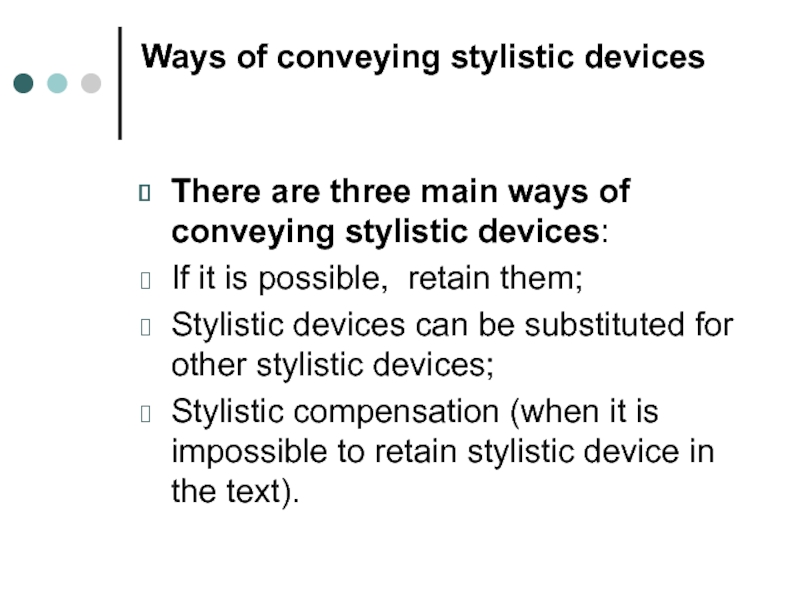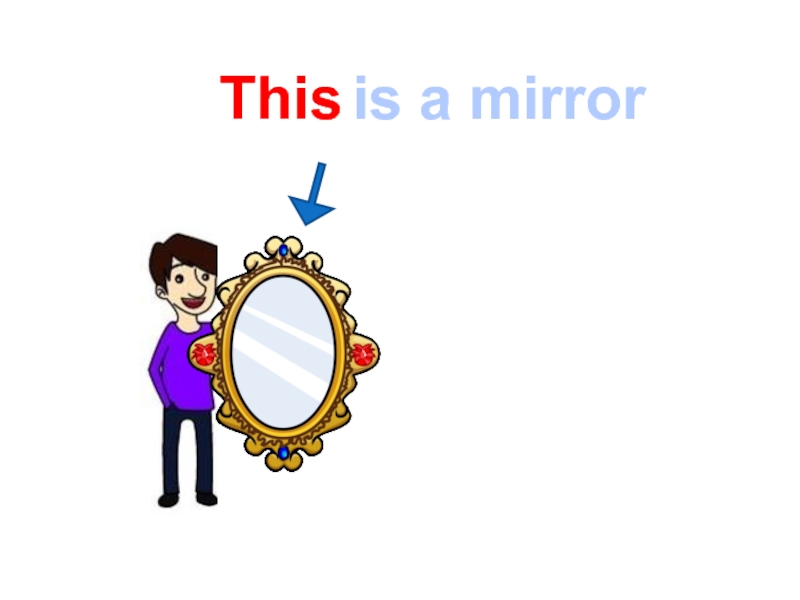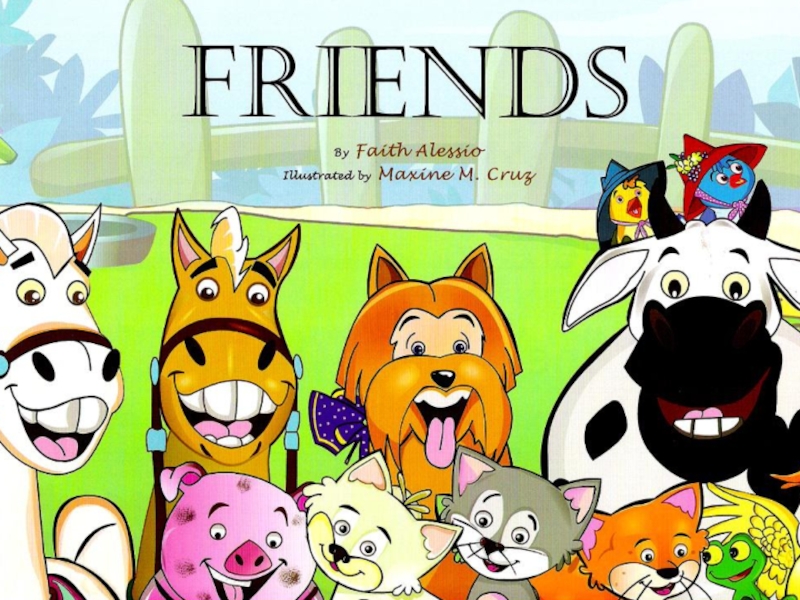- Главная
- Разное
- Дизайн
- Бизнес и предпринимательство
- Аналитика
- Образование
- Развлечения
- Красота и здоровье
- Финансы
- Государство
- Путешествия
- Спорт
- Недвижимость
- Армия
- Графика
- Культурология
- Еда и кулинария
- Лингвистика
- Английский язык
- Астрономия
- Алгебра
- Биология
- География
- Детские презентации
- Информатика
- История
- Литература
- Маркетинг
- Математика
- Медицина
- Менеджмент
- Музыка
- МХК
- Немецкий язык
- ОБЖ
- Обществознание
- Окружающий мир
- Педагогика
- Русский язык
- Технология
- Физика
- Философия
- Химия
- Шаблоны, картинки для презентаций
- Экология
- Экономика
- Юриспруденция
Stylistic aspects of translation презентация
Содержание
- 1. Stylistic aspects of translation
- 2. Handling Stylistically-Marked Language Units Handling Stylistic Devices
- 3. Handling stylistically-marked language units In different communicative
- 4. Handling stylistically-marked language units The principle stylistic
- 5. Handling stylistically-marked language units Some phrases become
- 6. Handling stylistically-marked language units Stylistically-marked units may
- 7. Handling stylistically-marked language units Some of the
- 8. Handling stylistically-marked language units A special group
- 9. Handling stylistically-marked language units Complicated translation problems
- 10. Handling stylistically-marked language units It would be
- 11. Handling stylistically-marked language units He do look
- 12. Написано у русского автора: «Ой, лють
- 13. “It would be murder out there
- 14. Handling Stylistic Devices Causes: Different words
- 15. Causes: Stylistic devices are necessary
- 16. Causes: One and the same
- 17. Causes: Stylistic devices in different
- 18. STYLISTIC devices Stylistic Devices: Metaphor: -
- 19. STYLISTIC METHODS OF TRANSLATION One should take
- 20. Alliteration Alliteration- is the repetition of the
- 21. Alliteration (functions) The author may use alliteration
- 22. Alliteration to establish logical connection between the
- 23. Alliteration Very often it is not necessary
- 24. STYLISTIC METHODS OF TRANSLATION - Alliteration
- 25. Alliteration Alliteration should be preserved when possible
- 26. Metaphor Metaphor is a stylistic device which
- 27. Ways of rendering metaphor In case it
- 28. Problems of conveying metaphors: the difference in
- 29. Problems of conveying metaphors the metaphoric expressions
- 30. Problems of conveying metaphors any changes in
- 31. Problems of conveying metaphors the metaphor in
- 32. Problems of conveying metaphors and simile Metaphors
- 33. Problems of conveying metaphors and simile Ways
- 34. Problems of conveying metaphors and simile by
- 35. Problems of conveying metonymy Metonymy- is transference
- 36. Problems of conveying metonymy e.g. Two men
- 37. Problems of conveying metonymy This example contains
- 38. Problems of conveying metonymy While in metaphor
- 39. Problems of conveying metonymy The most difficult
- 40. Ways of rendering metonymy by means of
- 41. Ways of rendering metonymy the difference both
- 42. Ways of rendering metonymy by means of
- 43. Ways of rendering metonymy e.g. Very soon
- 44. Ways of rendering metonymy by means of
- 45. Ways of rendering metonymy e.g. These wheels
- 46. Ways of rendering metonymy by choosing absolute
- 47. Ways of rendering metonymy Word-for-word translation due
- 48. Ways of rendering metonymy by means of
- 49. Ways of rendering metonymy E.g. The guards
- 50. Ways of rendering synecdoche Synecdoche- this variety
- 51. Ways of rendering synecdoche The second is
- 52. Problems of conveying synecdoche The means of
- 53. Problems of conveying synecdoche “Ваш чудовий друг
- 54. Problems of conveying epithet Metonymic epithet -
- 55. Problems of conveying antonomasia Antonomasia- is based
- 56. Problems of conveying antonomasia Cultural differences.
- 57. Ways of conveying stylistic devices There
- 58. Assignment for the seminar: Test
Слайд 3Handling stylistically-marked language units
In different communicative situations the language users select
words of different stylistic status.
The translator tries to preserve the stylistic status of the original text, by using the equivalents of the same style or, failing that, opting for stylistically neutral units.
The translator tries to preserve the stylistic status of the original text, by using the equivalents of the same style or, failing that, opting for stylistically neutral units.
Слайд 4Handling stylistically-marked language units
The principle stylistic effect of the text is
created with the help of special stylistic devices.
The speaker may qualify every object he mentions in his own way thus giving his utterance a specific stylistic turn.
Such stylistic phrasing gives much trouble to the translator since their meaning is often subjective and elusive.
The speaker may qualify every object he mentions in his own way thus giving his utterance a specific stylistic turn.
Such stylistic phrasing gives much trouble to the translator since their meaning is often subjective and elusive.
Слайд 5Handling stylistically-marked language units
Some phrases become fixed through repeated use and
they may have permanent equivalents in TL,
e.g. true love — истинная любовь, dead silence — мертвая тишина, good old England - добрая старая Англия.
But in most cases, however, the translator has to look for an occasional substitute, which often requires an in-depth study of the broad context
e.g. true love — истинная любовь, dead silence — мертвая тишина, good old England - добрая старая Англия.
But in most cases, however, the translator has to look for an occasional substitute, which often requires an in-depth study of the broad context
Слайд 6Handling stylistically-marked language units
Stylistically-marked units may also be certain types of
collocations.
Idiomatic phrases may be cited as an example.
Another common type includes conventional indirect names of various objects or "paraphrases".
A frequent use of paraphrases is a characteristic feature of the English language.
Idiomatic phrases may be cited as an example.
Another common type includes conventional indirect names of various objects or "paraphrases".
A frequent use of paraphrases is a characteristic feature of the English language.
Слайд 7Handling stylistically-marked language units
Some of the paraphrases are borrowed from such
classical sources as mythology or the Bible and usually have permanent equivalents in Russian (Attic salt - аттическая соль, the three sisters - богини судьбы, the Prince of Darkness - принц тьмы).
Others are purely English and are either transcribed or explained in translation:
John Bull — Джон Буль, the three R's — чтение, письмо и арифметика, the Iron Duke - герцог Веллингтон.
Others are purely English and are either transcribed or explained in translation:
John Bull — Джон Буль, the three R's — чтение, письмо и арифметика, the Iron Duke - герцог Веллингтон.
Слайд 8Handling stylistically-marked language units
A special group of paraphrases are the names
of countries, states and other geographical or political entities:
the Land of Cakes (Scotland), the Badger State (Wisconsin), the Empire City (New York).
As a rule, such paraphrases are not known to the Russian reader and they are replaced by official names in the translation.
the Land of Cakes (Scotland), the Badger State (Wisconsin), the Empire City (New York).
As a rule, such paraphrases are not known to the Russian reader and they are replaced by official names in the translation.
Слайд 9Handling stylistically-marked language units
Complicated translation problems are caused by ST containing
substandard language units used to produce a stylistic effect.
The ST author may imitate his character's speech by means of dialectal or contaminated forms.
SL territorial dialects cannot be reproduced in TT, nor can they be replaced by TL dialectal forms.
The ST author may imitate his character's speech by means of dialectal or contaminated forms.
SL territorial dialects cannot be reproduced in TT, nor can they be replaced by TL dialectal forms.
Слайд 10Handling stylistically-marked language units
It would be inappropriate if a black American
or a London cockney spoke in the Russian translation in the dialect, say, of the Northern regions of Russia or western part of Ukraine.
Fortunately, the English dialectal forms are mostly an indication of the speaker's low social or educational status, and they can be rendered into Russian by a legal employment of low-colloquial elements, e.g.:
Fortunately, the English dialectal forms are mostly an indication of the speaker's low social or educational status, and they can be rendered into Russian by a legal employment of low-colloquial elements, e.g.:
Слайд 11Handling stylistically-marked language units
He do look quiet, don't 'e? D'e know
'oo 'e is, Sir?
Вид-то у него спокойный, правда? Часом не знаете, сэр, кто он будет?
Вид-то у него спокойный, правда? Часом не знаете, сэр, кто он будет?
Слайд 12
Написано у русского автора:
«Ой, лють там сегодня будет: двадцать семь с
ветерком, ни укрыва, ни грева!»
In translation:
“Oh, it’d be cruel there today: seventeen degrees below zero, and windy. No shelter. No fire.” (Parker)
In translation:
“Oh, it’d be cruel there today: seventeen degrees below zero, and windy. No shelter. No fire.” (Parker)
Слайд 13
“It would be murder out there – twenty-seven below, with a
mean wind blowing, no shelter, and no hope of a warm!” (Garry Wyllets)
Слайд 14Handling Stylistic Devices
Causes:
Different words may acquire additional lexical meanings which
are not fixed in the dictionaries in a certain context (contextual meanings).
Transferred meaning reflects the interrelation between the two types of lexical meaning: dictionary and contextual.
Transferred meaning reflects the interrelation between the two types of lexical meaning: dictionary and contextual.
Слайд 15Causes:
Stylistic devices are necessary when the deviation from the acknowledged
meaning is carried to a degree which causes an unexpected turn in the recognized logical (dictionary) meanings.
Слайд 16Causes:
One and the same stylistic device may be used with
different frequency, perform different functions and have different meanings in the stylistic system of any language.
Слайд 17Causes:
Stylistic devices in different languages are the same in their
core, but they function differently in languages.
This is the cause of stylistic transformations.
This is the cause of stylistic transformations.
Слайд 18STYLISTIC devices
Stylistic Devices:
Metaphor: - Prolonged metaphor;
Metonymy: - Synecdoche;
- Metonymic epithet;
Antonomasia;
Alliteration.
Antonomasia;
Alliteration.
Слайд 19STYLISTIC METHODS OF TRANSLATION
One should take into account that while translating
there is coincidence, partial coincidence and divergences of rendering stylistic devices.
Слайд 20Alliteration
Alliteration- is the repetition of the initial consonant in two or
more words. It can be used for emphasis, logical connection between the components.
e.g. Nothing befalls him that he can not transmute into a stanza, song or story.
Все что происходит с писателем может отображаться в его песнe, поэме, или повести.
e.g. Nothing befalls him that he can not transmute into a stanza, song or story.
Все что происходит с писателем может отображаться в его песнe, поэме, или повести.
Слайд 21Alliteration (functions)
The author may use alliteration for the following purposes:
to create
consonance and aid memorization
(Peter Piper Picked a Peck of Pickled Peppers. Про пестрых птиц поет петух, про перья пышные, про пух.);
(Peter Piper Picked a Peck of Pickled Peppers. Про пестрых птиц поет петух, про перья пышные, про пух.);
Слайд 22Alliteration
to establish logical connection between the components
(cold comfort – слабое
утешение; cold conditions – нерабочий режим);
to attract the reader’s attention
(Britain’s Biggest Bazaar – крупнейшая распродажа в Великобритании).
to attract the reader’s attention
(Britain’s Biggest Bazaar – крупнейшая распродажа в Великобритании).
Слайд 23Alliteration
Very often it is not necessary to retain alliteration while translating:
e.g.
Rolls on the Rock – банкpутство компанії Роллс-Ройс;
Слайд 24STYLISTIC METHODS OF TRANSLATION
- Alliteration is often omitted when used
in newspaper and publicistic style, where the informative function is the primary one:
E.g. Bar Barbarism in Bars – Запретить варварство в барах.
E.g. Bar Barbarism in Bars – Запретить варварство в барах.
Слайд 25Alliteration
Alliteration should be preserved when possible if the poetic function is
more important than the informative one:
E.g. The word Papa gives the pretty form to the lips: potatoes, poultry, prunes and prisms, and all very good for the lips.
Слово «папа» придает изящную форму губам: папа, палисандр, персики и призмы – прекрасные слова.
E.g. The word Papa gives the pretty form to the lips: potatoes, poultry, prunes and prisms, and all very good for the lips.
Слово «папа» придает изящную форму губам: папа, палисандр, персики и призмы – прекрасные слова.
Слайд 26Metaphor
Metaphor is a stylistic device which consists in the usage of
words in a figurative transferred meaning based on the analogy or similarity and is used in all emotive styles.
e.g. hot money- горячие деньги.
It is important to retain metaphors when dealing with fiction.
e.g. hot money- горячие деньги.
It is important to retain metaphors when dealing with fiction.
Слайд 27Ways of rendering metaphor
In case it is impossible to retain it,
the metaphor should be then compensated or substituted for another stylistic device.
Слайд 28Problems of conveying metaphors:
the difference in traditional associations related to some
notions or phenomena.
e.g. black sheep- паршивая овца,
black frost- трескучий мороз
the metaphors those origin lie in the national folklore
e.g. красна девица- fair maiden,
добрый молодец- brave man
e.g. black sheep- паршивая овца,
black frost- трескучий мороз
the metaphors those origin lie in the national folklore
e.g. красна девица- fair maiden,
добрый молодец- brave man
Слайд 29Problems of conveying metaphors
the metaphoric expressions which have the same origin
for the both SL and TL but are expressed differently.
e.g. Bавилонское столпотворение- the confusion of Babylon
Дары данайцев- The Greek gifts
e.g. Bавилонское столпотворение- the confusion of Babylon
Дары данайцев- The Greek gifts
Слайд 30Problems of conveying metaphors
any changes in the metaphor can lead to
reconstruction of the whole phrase
e.g. SPARKLER- Light up your life!
СПАРКЛЕР- БРИЛЛИАНТ ЧИСТЕЙШЕЙ ВОДЫ!
e.g. SPARKLER- Light up your life!
СПАРКЛЕР- БРИЛЛИАНТ ЧИСТЕЙШЕЙ ВОДЫ!
Слайд 31Problems of conveying metaphors
the metaphor in the process of translation can
be substituted for metaphoric epithet, simile, etc.
e.g. a beast of a car- не машина, а зверь
an angel of a girl- не девушка, а ангел/ ангелоподобная девушка
e.g. a beast of a car- не машина, а зверь
an angel of a girl- не девушка, а ангел/ ангелоподобная девушка
Слайд 32Problems of conveying metaphors and simile
Metaphors and similes are lexical figures
of speech.
Both metaphor and simile are terms that describe a comparison: the only difference between a metaphor and a simile is that a simile makes the comparison explicit by using "like" or "as":
You are my sunshine (metaphor) – Your eyes are like the sun (simile).
Both metaphor and simile are terms that describe a comparison: the only difference between a metaphor and a simile is that a simile makes the comparison explicit by using "like" or "as":
You are my sunshine (metaphor) – Your eyes are like the sun (simile).
Слайд 33Problems of conveying metaphors and simile
Ways of rendering metaphors and similes:
-
by choosing absolute equivalents where the image is preserved:
E.g. white as a sheet – бледный как полотно/простыня.
by finding near equivalents when the image of the SL phrase is substituted for the different one:
E.g. old as the hills – старо как мир.
E.g. white as a sheet – бледный как полотно/простыня.
by finding near equivalents when the image of the SL phrase is substituted for the different one:
E.g. old as the hills – старо как мир.
Слайд 34Problems of conveying metaphors and simile
by means of word-for-word translation:
E.g. As
busy as a bee – занят как пчела.
by means of descriptive way of translation:
E.g. As large as life – в натуральную величину
by means of descriptive way of translation:
E.g. As large as life – в натуральную величину
Слайд 35Problems of conveying metonymy
Metonymy- is transference of a name of one
object to another object.
Metonymic transference of name is based upon the principle of contiguity of two objects.
Metonymic transference of name is based upon the principle of contiguity of two objects.
Слайд 36Problems of conveying metonymy
e.g. Two men entered the room. The red
was smiling, the black was upset.
Двое мужчин вошли в комнату. Рыжий улыбался, а черный был грустный.
Двое мужчин вошли в комнату. Рыжий улыбался, а черный был грустный.
Слайд 37Problems of conveying metonymy
This example contains the original metonymy is quite
simple to translate since the structural and semantic expressions are the same in the SL and TL.
Metonymy may be instructively contrasted with metaphor.
Both figures involve the substitution of one term for another.
Metonymy may be instructively contrasted with metaphor.
Both figures involve the substitution of one term for another.
Слайд 38Problems of conveying metonymy
While in metaphor this substitution is based on
similarity, in metonymy the substitution is based on contiguity.
Metaphor example: The ship plowed through the sea (plowed instead of navigated).
Metonymy example: The sails crossed the ocean (sails instead of ship with sails).
Metaphor example: The ship plowed through the sea (plowed instead of navigated).
Metonymy example: The sails crossed the ocean (sails instead of ship with sails).
Слайд 39Problems of conveying metonymy
The most difficult to render are metonymies based
on the associations between:
- the object and its quality (metonymic epithet);
- the whole and its part (synecdoche);
- the proper and common names (antonomasia).
- the object and its quality (metonymic epithet);
- the whole and its part (synecdoche);
- the proper and common names (antonomasia).
Слайд 40Ways of rendering metonymy
by means of reconstruction of the common name
(in case the original metonymic word has neither equivalent nor analogue in the TL and is not known to the target reader due to different cultural traditions):
Слайд 41Ways of rendering metonymy
the difference both in the means of metonymization
and the extent to which it has spread in the SL and TL.
different traditions and rules of metonymic expressions.
e.g. To buy some Kellog’s- купить кукурузные хлопья.
different traditions and rules of metonymic expressions.
e.g. To buy some Kellog’s- купить кукурузные хлопья.
Слайд 42Ways of rendering metonymy
by means of structural transformations
(in case grammatical
norms of the two languages are different, and the context cannot be rendered equivalently in terms of grammar):
structural transformations and discrepancies in the grammatical norms
structural transformations and discrepancies in the grammatical norms
Слайд 43Ways of rendering metonymy
e.g. Very soon after words there was a
concerned official’s face staring at me through the jagged hole in the glass of the kitchen door.
Вскоре из дыры в стекле кухонной двери на меня уставилось озадаченное лицо представителя закона.
Вскоре из дыры в стекле кухонной двери на меня уставилось озадаченное лицо представителя закона.
Слайд 44Ways of rendering metonymy
by means of functional transformations
(in case
the stylistic status of the metonymy is different in the source and target languages):
functional transformations when the stylistic status of the metonymic expression do not coincide in SL and TL
functional transformations when the stylistic status of the metonymic expression do not coincide in SL and TL
Слайд 45Ways of rendering metonymy
e.g. These wheels will drive you at your
pleasure.
Ваш замечательный друг на колесах гарантирует Вам комфортное передвижение и приятные эмоции .
Ваш замечательный друг на колесах гарантирует Вам комфортное передвижение и приятные эмоции .
Слайд 46Ways of rendering metonymy
by choosing absolute equivalents (in case there is
a complete coincidence between the cultural traditions of expressing individual qualities of a certain object in the source and target languages):
Слайд 47Ways of rendering metonymy
Word-for-word translation due to full correspondence both in
cultural and in individual properties of the metonymic expressions
e.g. I am revolt of the stupidity of a country police.
Меня возмущает глупость полиции.
e.g. I am revolt of the stupidity of a country police.
Меня возмущает глупость полиции.
Слайд 48Ways of rendering metonymy
by means of reconstruction of the basis for
metonymic transference
(in case the metonymic transference used in the SL does not sound natural in the TL in a particular situation):
(in case the metonymic transference used in the SL does not sound natural in the TL in a particular situation):
Слайд 49Ways of rendering metonymy
E.g. The guards now change at Buckingham Palace
to a Lennon and McCartney .
Смена караула у Букингемского дворца проходит сегодня под музыку Леннона и Маккартни .
Смена караула у Букингемского дворца проходит сегодня под музыку Леннона и Маккартни .
Слайд 50Ways of rendering synecdoche
Synecdoche- this variety of metonymy is realized in
two variants.
The first variant is naming the whole object by mentioning part of it.
e.g. Caroling lives with Jack under the same roof.
Каролин живет с Джеком под одной крышей.
The first variant is naming the whole object by mentioning part of it.
e.g. Caroling lives with Jack under the same roof.
Каролин живет с Джеком под одной крышей.
Слайд 51Ways of rendering synecdoche
The second is using the name of the
whole object to denote a constituent part of this object.
e.g. The hall applauded.
Холл аплодировал.
e.g. The hall applauded.
Холл аплодировал.
Слайд 52Problems of conveying synecdoche
The means of its expression may often be
different in SL and TL.
Sometimes it requires the replacement of the stylistic device
e.g. These wheels will drive you at your pleasure. “These wheels” stands for this car.
We cannot say “колеса” because it will not correspond to genre of ad.
Sometimes it requires the replacement of the stylistic device
e.g. These wheels will drive you at your pleasure. “These wheels” stands for this car.
We cannot say “колеса” because it will not correspond to genre of ad.
Слайд 53Problems of conveying synecdoche
“Ваш чудовий друг на колесах” або “ці чудові
колеса, сучасний дизайн й автоматичне керування гарантують вам їзду із задоволенням”.
Слайд 54Problems of conveying epithet
Metonymic epithet - on basis of association between
the object and of its qualities or features.
e.g. У кабінет буквально ввалилося джинсове дівчисько. –
A girl in her full denim outfit nearly fell into the office.
The only way of translation is changing the attribute into the object, but at the same time part of SL emotive and evaluative information is lost.
e.g. У кабінет буквально ввалилося джинсове дівчисько. –
A girl in her full denim outfit nearly fell into the office.
The only way of translation is changing the attribute into the object, but at the same time part of SL emotive and evaluative information is lost.
Слайд 55Problems of conveying antonomasia
Antonomasia- is based upon the principle of identification
of human beings with things which surround them.
e.g. John is a real Romeo.
Джон- настоящий Ромео.
e.g. John is a real Romeo.
Джон- настоящий Ромео.
Слайд 56Problems of conveying antonomasia
Cultural differences.
While translating names the translator has
to reconstruct the basis for the metonymic substitution because the antonomasia is not widely used in Russian.
e.g. “Old Blue Eyes” for Frank Sinatra.
“The King” for Elvis Prestly.
e.g. “Old Blue Eyes” for Frank Sinatra.
“The King” for Elvis Prestly.
Слайд 57Ways of conveying stylistic devices
There are three main ways of conveying
stylistic devices:
If it is possible, retain them;
Stylistic devices can be substituted for other stylistic devices;
Stylistic compensation (when it is impossible to retain stylistic device in the text).
If it is possible, retain them;
Stylistic devices can be substituted for other stylistic devices;
Stylistic compensation (when it is impossible to retain stylistic device in the text).
